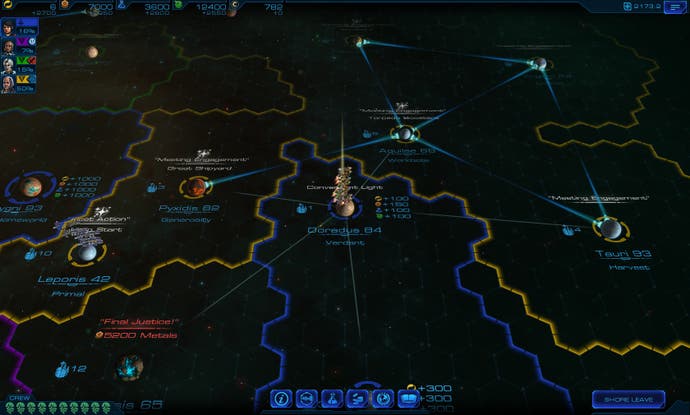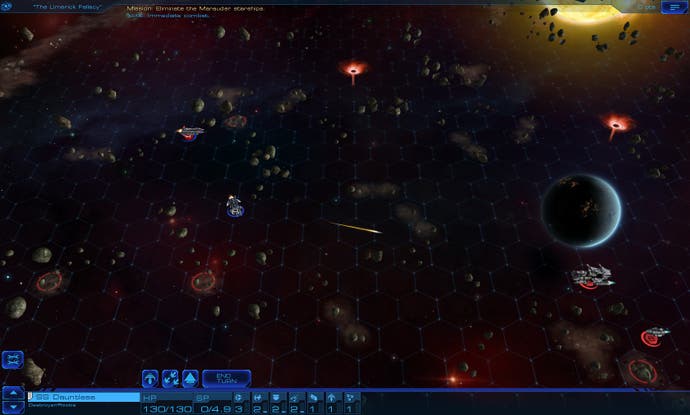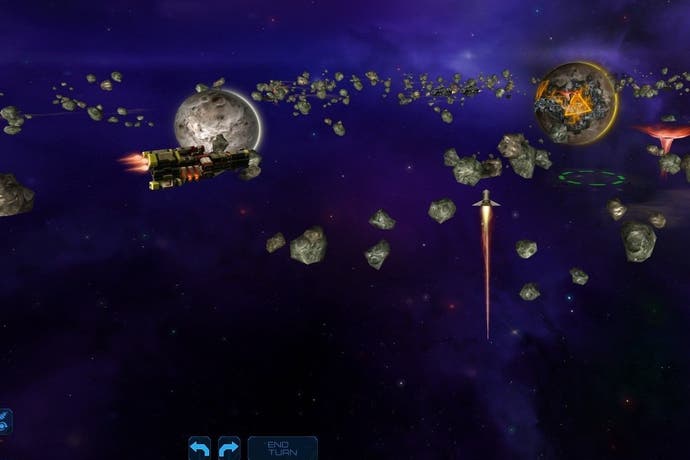Sid Meier's Starships review
Beyond Beyond Earth.
Sid Meier's Starships shares one crucial theme with Civilization: Beyond Earth, the game whose story it loosely continues. Both titles hinge on a very simple idea, powerfully stated: the worst thing you're ever likely to find floating around out in space is another human being.
In many ways, Firaxis' latest offers even greater scope for our wretched species to express itself. Well, a greater stage, at any rate. Beyond Earth limited itself to the atrocities we might cause when scouting a new homeworld. Starships, however, throws open the entire galaxy. We're not finding out feet anymore. In fact, we've been granted wings. Cue gunship diplomacy. (Just me?)
Beyond that - and beyond a few themed unlockable treats - actual links between both games tend to be relatively cosmetic. Before you begin each match here, you choose from a familiar muddle of affinities and faction leaders, but they're all just starting perks, really, and while the game that lies beyond these choices is a turn-based affair, it's far breezier than Beyond Earth: a nice territory-capture strategy treat as you move between planets, a compact hex-based battler when you get into orbit around one.

If you were expecting a full-blown follow-up to Beyond Earth, in other words, this isn't it. And that doesn't really matter, because instead this is a wonderful knockabout timewaster, with matches designed to eat up an afternoon - or a succession of bus trips if you're playing on iPad - rather than a whole weekend. It's one of Firaxis' fabled Sid Projects, too: Meier's listed as both designer and a programmer here, and the end result has much of the cheery playfulness you may have found in Ace Patrol (another recent Sid Project that straddled both iPads and PCs). It's not a throwaway game by any means, it's just one that's built to plug very specific gaps in your life.
While you can still score classic Civ-style victories involving domination, science, and the building of wonders, the main thrust of Starships is the population victory. Out beyond your home planet is an entire galaxy - go and capture 51 percent of it. You do this by bringing planets into your civ's fold, and you do that by building up your influence, either by paying for it, or by performing missions that pop up the first time you visit. Gain four levels of influence on a planet and it's yours - although in contested areas, expect a bit of back-and-forth before you snag your prize.
Missions are where the game's tactical heart is to be found. Head to a planet, accept a mission, and you're whisked away to a hex-based view of the battlefield, a surprisingly rangy area of space riddled with asteroids and even the odd planet. Objectives vary from maze-runs, survive-five-turn games and even escort jobs (surprisingly non-terrible escort jobs), but the meat of them is always the same: your current starship armada against somebody else's.

It's an ideal introduction to turn-based tactics games, really, encouraging you to think about everything from placement and orientation to secondary abilities. Ships can move within a set radius, and can also perform a range of simple actions - firing with lasers or deadlier weapons, launching glass-cannon fighter squadrons, repairing damage, or even turning on stealth systems. Everything has its own quirks, from lasers that cover long distances but tend to be fairly weak, to torpedos - beautiful, beautiful torpedos - that are launched along a set trajectory and then move down their path for a number of turns until you decide to detonate them, often in empty space because everyone has already seen you coming and run away. Like Star Trek, Starships' combat has a wonderful naval feel to it, and proceedings are enhanced by clusters of asteroids scattered here and there that may block or diminish shots, or may even open up now and then, allowing you to slip through.
Enemies, meanwhile, scale from simple marauders - think of them as space barbarians - to the other civs you're playing against, the latter in battles triggered when you decide to drop diplomacy and move in on their planets. In truth, I'm not sure the AI is fantastically imaginative, but your foes at least know when to drop back and take it easy and when to pick on the weakest member of your fleet.

Beyond all this, there's a pleasant dusting of complexity, most of which is tuned towards handing out little mechanical advantages: faster engines, more effective lasers, that sort of thing. You can build cities and improvements and wonders around the planets you own, and those give you resources and perks. You can invest science in new tech, which also provides more perks. (These things also contribute to either science or wonder victories in their own right, of course.) There's also a stripped-down version of diplomacy, and even a little crew management to take into account, as your men will require regular shore leave if they're to perform at full capacity - shore leave during which you get to see the other civs gadding around and nicking all your stuff.
If anything's been slightly neglected, it's actually the starships themselves - a weird problem for a game called Starships, but not a catastrophic one in this case. As you spread out through space, you'll accrue more energy, which you can spend on additional members of your fleet and general improvements to any ships you already have. During the lead-up to Starships' release, I had gotten it into my head that there was an element of tangible player design to all of this, but in general it's limited to buying set modules - engines, lasers, sensors and the like - and then plugging more energy into them to upgrade them. The starship models update themselves as you work, and there are wonderfully chunky designs for each civ. You also have to think about the performance effects of clamping on too much artillery. Ultimately it feels like a little bit of a missed opportunity, though: not in terms of strategy so much as in fostering a genuine sense of ownership. You can't rename your ships, for example - a tiny mechanical detail, perhaps, but a crucial one when it comes to the emotional weight a simple trick like that can have in a strategy game. Imagine an XCOM in which you couldn't rename your own soldiers.
Still, small beans in a game that is otherwise so elegantly put together. Starships isn't Civ, but it is Sid, and that's fine by me.



